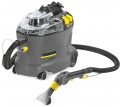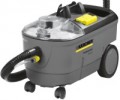Motor power
Rated power consumed by the vacuum cleaner. In models with power adjustment (see below), the maximum value is taken into account in this case. We are talking about the characteristics of the installed motor, which is the main, and in most vacuum cleaners, the only consumer of energy.
Higher power increases suction force and improves overall cleaning efficiency. In addition, a more powerful unit is easier to equip with a capacious dust collector. On the other hand, only vacuum cleaners of the same type with the same types of dust collectors can be directly compared by this parameter (see above for both). And even in such cases, the actual suction force (see below) may be different — and it is it that determines the real efficiency. However, the total power also allows you to generally evaluate the capabilities of the vacuum cleaner, including in comparison: a 1500 W model will significantly outperform its 800 W counterpart in efficiency (although it is impossible to say exactly by how much). But what definitely depends on this indicator is energy consumption.
As for specific power values, they are largely related to the type of device. For example, handheld models, robots and uproght units have low power —
less than 1500 W(and often noticeably less). Such values are quite popular among other types of vacuum cleaners (conventional, industrial, workshop, etc.), but among them there are already more solid indicators —
...f="/list/90/pr-1067/">1500 – 1750 W,
1750 – 2000 W and even
more than 2000 W.Dust collector capacity
The nominal volume of the dust collector installed in the vacuum cleaner.
This indicator largely depends on the type of unit (see above). For example, in most handheld household models, the capacity
does not exceed 0.5 L. The volume of the container in upright vacuum cleaners and robots can be somewhat larger — among the first variety there are quite a few models for
1 – 2 liters or even more, and among the second — by
0.6 – 1 liter and a little more. For conventional vacuum cleaners, the minimum figure is actually about 0.8 – 1 L; dust collectors for 1 – 2 L and
2 – 4 L are very popular in such devices; the maximum capacity is actually
4 – 6 liters — units of a similar layout, but with a larger capacity, are usually referred to as household ones. In turn, relatively small containers are occasionally found among workshop models. However, in vacuum cleaners of this type, the capacity is generally quite large — it can reach
26 – 50 liters or even
more ; the same applies to industrial (construction) units.
In general, a larger dust container allows you to work longer without interruptions. On the other hand, a capacious container itself takes up more space and, accordingly, affects the size, weight and price. So when choosing th
...is parameter, it is worth considering the actual features of the use of a vacuum cleaner. Here we can give such an example: for a full-scale cleaning of an average city apartment, a capacity of about 1 – 1.5 litres is required. Thus, say, a 4-litre bag allows you to carry out two such cleanings with sufficient efficiency without unloading the vacuum cleaner. There are more detailed recommendations regarding the optimal volume of the dust collector, including specific cleaning options. These recommendations can be found in special sources.Water tank capacity
A capacity of a tank for water or detergent a vacuum cleaner with a wet cleaning function is equipped with. (see "Cleaning type").
Large capacity allows you to work longer without refilling the tank. On the other hand, an increase in capacity has a corresponding effect on the size, weight and cost of the unit. Thus, manufacturers choose this parameter taking into account the general specialization and the “weight category” of a particular model. So, in robots (see "Type"), the volume of the water tank is, by definition, small. Even in the heaviest models, it does not exceed 650 mL. But other types of vacuum cleaners can differ markedly in this parameter.
In general, for non-robot units, a capacity
of 1 liter or less is considered very limited,
1 – 2 liters is small,
2 – 3 liters is average,
more than 3 liters is above average. However, it much depends on the type. For example, in conventional vacuum cleaners, the capacity does not exceed 2.5 liters, and "for workshop" models this is very little — in most cases, they have a tank capacity of 3 liters or more.
Noise level
The noise level produced by the vacuum cleaner during operation. Usually, the value for normal operation at maximum engine power is indicated here. With less power, the loudness of the unit may be lower, but the key is precisely the maximum indicator.
Regarding specific numbers, keep in mind that the decibel used to measure the noise level is a non-linear quantity. Therefore, it is worth evaluating specific indicators using special comparative tables. In general, vacuum cleaners are quite noisy appliances; so in this case, models are considered quiet if this indicator
does not exceed 65 dB — this is the level of a loud conversation between 2 – 3 people at a distance of 1 m. The quietest of these models give out only 40 dB — this is the average volume of a person’s speech in normal tones (and the minimum volume allowed for constant noise sources in living quarters during the day). For louder units, the comparison table looks like this:
—
66 – 70 dB — loud conversations between several groups of people at a distance of about 1 m;
—
71 – 75 dB — the volume of a cry or laughter in full voice at a distance of about 1 m;
—
76 – 80 dB — the volume of a mechanical alarm clock or the engine of an old truck;
—
more than 80 dB — a very high noise level, exceeding the level of a loud scr
...eam; when working with a vacuum cleaner having such specifications for a long time, it is highly desirable to use hearing protection.
Also note that the noise level largely depends on the engine power, as well as some other features (for example, it is strongly affected by the presence of an aquafilter — see "Dust collector"). At the same time, there is no hard connection here, and units with a similar set of specifications can differ markedly in actual loudness. In such cases, when choosing here, it is worth proceeding from the fact that a quieter vacuum cleaner will be more comfortable to use. However, it will most likely cost noticeably more.Tube type
The type of rigid tube supplied with the vacuum cleaner.
The most popular are
telescopic tubes, extension tubes are much less common, and with some upright with handheld vacuum cleaners (see "Type"), tubes
with a hinge are supplied in the kit (they are also "bendable" or "flex"). Here is a more detailed description of each option:
— Telescopic tube. Non-separable tube folded telescopically — by inserting one section into another. This option is the most convenient from the user's point of view. Firstly, such accessories are easy to unfold and fold — just press or slide the release key and pull or push the halves in the right direction. Secondly, many telescopic tubes are equipped with a mechanism that allows the structure to be unfolded incompletely. Thanks to this, you can adjust the length during the cleaning process (for example, reduce it to work in cramped conditions). Thirdly, the individual parts of such a tube can't be lost, which simplifies storage. The main disadvantage of this option is considered to be somewhat lower strength and reliability than that of extension tubes. However, this difference is noticeable only at high loads. Thus, telescopic tubes are very popular in conventional vacuum cleaners (see "Type"), but they are found in other types, including industrial (construction). The “telescope” cannot be found in only three types of vacuum cleaners: in robots (they do no
...t use tubes), as well as, in industrial handheld units and fireplace models — they most often work only with a hose.
— Extension tubes. A tube consists of several parts connected during operation and disassembled for storage/transportation. Such designs are somewhat less convenient to use than telescopic ones, but they endure high loads much better and last longer. Thus, extension tubes are rarely used in conventional vacuum cleaners, but they are popular in professional units — industrial, workshop, etc.
— Bendable tube. A tube has a hinge in the middle and can bend at an upward angle. It is a rather specific option, used in some vacuum cleaners of the "upright with handheld" type. This design makes it much easier to clean with such a vacuum cleaner under sofas, beds, tables, etc. By bending the tube, you can effectively treat such places without lowering the vacuum cleaner body to the floor. On the other hand, the hinge significantly complicates the design and increases its cost, and far from all users, these disadvantages are outweighed by the mentioned ease of use. That is why this type of pipe is extremely rare.Cord length
The length of the power cord that is equipped with a vacuum cleaner powered by an outlet.
Here we note that manufacturers select the specific length of the cord depending on the general purpose of the unit. In general, the length
of 4 – 5 m and
less can be called small,
5 – 6 m — medium,
6 – 7 m and
7 – 8 m — more than average, and in some models this figure is
more than 8 m. However, a lot depends on the specifics of the vacuum cleaner. For example, among conventional units there are many models with a 4-5 m wire (this is enough for cleaning on the scale of an apartment, a private house or a small office space), but for industrial solutions this is a very limited indicator.
Keep in mind that a longer power cord is not always more convenient. On the one hand, it provides more freedom when working. On the other hand, it can create inconvenience at a short distance from the outlet as well as during storage/transportation. In addition, you can use an extension cord to work away from the outlet. So when choosing, you need to take into account the specific needs of the use of a vacuum cleaner. Detailed recommendations for different situations can be found in special sources.

